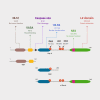Prostate apoptosis response-4 and tumor suppression: it's not just about apoptosis anymore
- PMID: 33414404
- PMCID: PMC7790818
- DOI: 10.1038/s41419-020-03292-1
Prostate apoptosis response-4 and tumor suppression: it's not just about apoptosis anymore
Abstract
The tumor suppressor prostate apoptosis response-4 (Par-4) has recently turned 'twenty-five'. Beyond its indisputable role as an apoptosis inducer, an increasing and sometimes bewildering, new roles for Par-4 are being reported. These roles include its ability to regulate autophagy, senescence, and metastasis. This growing range of responses to Par-4 is reflected by our increasing understanding of the various mechanisms through which Par-4 can function. In this review, we summarize the existing knowledge on Par-4 tumor suppressive mechanisms, and discuss how the interaction of Par-4 with different regulators influence cell fate. This review also highlights the new secretory pathway that has emerged and the likely discussion on its clinical implications.
Conflict of interest statement
The authors declare that they have no conflict of interest.
Figures







Similar articles
-
A journey beyond apoptosis: new enigma of controlling metastasis by pro-apoptotic Par-4.Clin Exp Metastasis. 2016 Dec;33(8):757-764. doi: 10.1007/s10585-016-9819-5. Epub 2016 Aug 27. Clin Exp Metastasis. 2016. PMID: 27568374 Review.
-
Oncogenic and tumor suppressive roles of microRNAs in apoptosis and autophagy.Apoptosis. 2014 Aug;19(8):1177-89. doi: 10.1007/s10495-014-0999-7. Apoptosis. 2014. PMID: 24850099 Review.
-
Systemic Par-4 inhibits non-autochthonous tumor growth.Cancer Biol Ther. 2011 Jul 15;12(2):152-7. doi: 10.4161/cbt.12.2.15734. Epub 2011 Jul 15. Cancer Biol Ther. 2011. PMID: 21613819 Free PMC article.
-
BLID: A Novel Tumor-Suppressor Gene.Oncol Res. 2014;22(5-6):333-8. doi: 10.3727/096504015X14410238486568. Oncol Res. 2014. PMID: 26629946 Free PMC article. Review.
-
Concomitant induction of apoptosis and autophagy by prostate apoptosis response-4 in hypopharyngeal carcinoma cells.Am J Pathol. 2014 Feb;184(2):418-30. doi: 10.1016/j.ajpath.2013.10.012. Am J Pathol. 2014. PMID: 24418097
Cited by
-
The Antitumor Potential of λ-Carrageenan Oligosaccharides on Gastric Carcinoma by Immunomodulation.Nutrients. 2023 Apr 24;15(9):2044. doi: 10.3390/nu15092044. Nutrients. 2023. PMID: 37432179 Free PMC article.
-
Tumor suppressor Par-4 activates autophagy-dependent ferroptosis.Commun Biol. 2024 Jun 17;7(1):732. doi: 10.1038/s42003-024-06430-z. Commun Biol. 2024. PMID: 38886572 Free PMC article.
-
Anti-Cancer and Anti-Proliferative Potential of Cannabidiol: A Cellular and Molecular Perspective.Int J Mol Sci. 2024 May 23;25(11):5659. doi: 10.3390/ijms25115659. Int J Mol Sci. 2024. PMID: 38891847 Free PMC article. Review.
-
Enhancing the Conformational Stability of the cl-Par-4 Tumor Suppressor via Site-Directed Mutagenesis.Biomolecules. 2023 Apr 12;13(4):667. doi: 10.3390/biom13040667. Biomolecules. 2023. PMID: 37189414 Free PMC article.
-
Epigenetic Editing in Prostate Cancer: Challenges and Opportunities.Epigenetics. 2022 May;17(5):564-588. doi: 10.1080/15592294.2021.1939477. Epub 2021 Jun 15. Epigenetics. 2022. PMID: 34130596 Free PMC article. Review.
References
-
- Sells SF, et al. Commonality of the gene programs induced by effectors of apoptosis in androgen-dependent and -independent prostate cells. Cell Growth Differ. 1994;5:457–466. - PubMed
-
- Boehrer S, et al. In lymphatic cells par-4 sensitizes to apoptosis by down-regulating bcl-2 and promoting disruption of mitochondrial membrane potential and caspase activation. Cancer Res. 2002;62:1768–1775. - PubMed
Publication types
MeSH terms
Substances
LinkOut - more resources
Full Text Sources
Other Literature Sources

